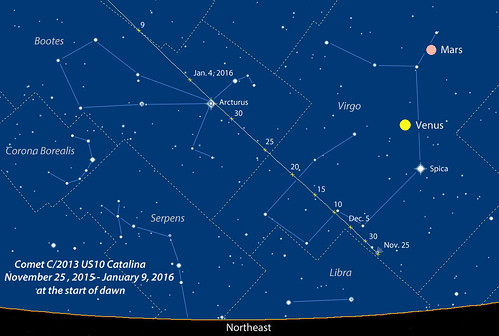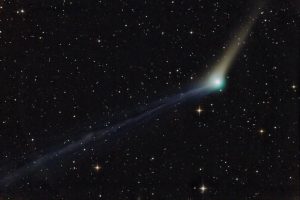
Latest
The comet is currently in the constellation of Canes Venatici heading towards Ursa Major shining at magnitude 6.3. Imagery before perihelion was able to show a green coma with tail stretching at least 3 degrees. Post perihelion images are showing two distinct tails. The fantastic image above was taken by Brian D. Ottum on December 6, 2015 from Rancho Hidalgo, New Mexico. It shows some impressive colour and structure in the ion tail. During the period between 9th and 17th January, Comet Catalina will pass close to the handle stars of the big dipper. This will be visible nearer the horizon after 11pm or best viewed higher in the sky after midnight. If viewers have any images of this please feel free to upload them to our gallery! The Comet’s brightness is expected to stay strong throughout January at magnitude 6. However, as with all comets, they are unpredictable.
History
Comet Catalina was discovered on 31 October 2013 by the Catalina Sky Survey with their 0.68 meter Schmidt-Cassegrain telescope. Its thought to have an orbital period of several million years. The comet will reach perihelion on 15 November 2015 at a distance of 0.82 AU. Through July and August the comet has been circumpolar in the Southern hemisphere reaching around magnitude 7. Through September it reached magnitude 6.5, just shy of naked eye visibility.
Current Location
Having rushed toward perihelion in November, the Comet has now headed towards the Northern sky. Throughout November, the Comet’s elongation made it a little difficult to observe in the morning twilight however through December, the comet climbs out of twilight. On new years eve, comet Catalina gets noticeably close to the bright star Arcturus in the constellation of Bootes. Latest observations predict that the comet will reach a peak brightness of magnitude 5 which brings it within naked eye visibility.
Now within the orbit of Mars, the comet is well within the zone of sublimation. This is where the icy body begins to awaken from its frozen state. The nucleus of the comet is currently loosing around 3000 kilograms of material per second!
Finder Charts
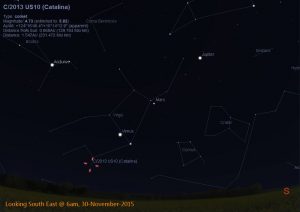 30th November 2015 @ 6am
30th November 2015 @ 6am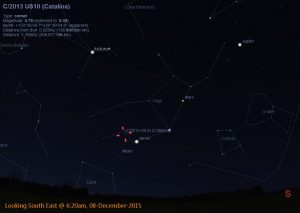 Comet Catalina, The Moon and Venus forms a triangle on the morning of 08th December 2015
Comet Catalina, The Moon and Venus forms a triangle on the morning of 08th December 2015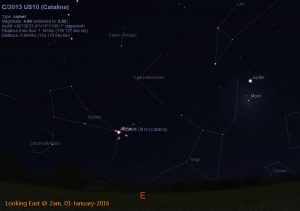 Comet Catalina and Arcturus are less than a degree apart on 01st January 2016!
Comet Catalina and Arcturus are less than a degree apart on 01st January 2016!As you can see from these charts, the comet isn’t visible in the Northern hemisphere until the end of November. At this time the Comet will reside in the morning twilight glow before sunrise. It’s expected to stay between visual magnitude 4-5.
